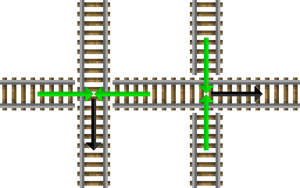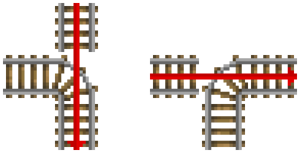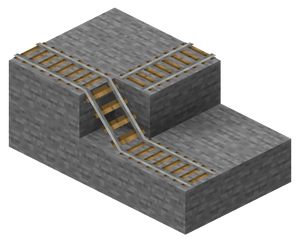Rails (also known as Minecart Tracks) are Non-Solid blocks first seen in the First "Seecret Friday Update" to Infdev. The block has several sprites depending on their orientation when laid. They appear as a 2D image of straight track in the player's hand. Tracks do not appear anywhere on a natural map. For now, tracks can only be crafted in Infdev, Alpha and Beta mode. In the Beta 1.5 update, the Powered Rail and the Detector Rail were added.
A Track's purpose is to provide a line along which Minecarts can move easily.
The track's texture was changed in the Halloween update.
Crafting
16 track pieces can be crafted from 6 Iron Ingots and 1 Stick, in the pattern below:
| Ingredients | Input » Output |
|---|---|
| Iron Ingots + Stick | Template:Grid/Crafting Table |
Behavior
Two directly adjacent tracks will attach inline to each other automatically. If two perpendicular track pieces meet, the track connecting them will turn into a curve.
If a track leads up to a 1 block high ledge, the piece placed up against the ledge will turn into a ramp if another track is placed on top of the ledge.
T intersections can be powered by Redstone circuits and their direction can change with Switches provided there is no confusion about the 2 directions to switch to. Separate tracks laid adjacent but at the next level lower or higher can sometimes cause issues. Since there are no formal rail junctions, switched T intersections are the only method by which the player can have a track system that leads in more directions than back and forth. In rare cases, curved track sections will not change appearance when their direction is changed. If a track switching mechanism seems to be inexplicably broken, test it by running a cart on the track rather than by looking at how the track appears to be oriented. Redstone circuits will not affect normal track blocks or track ramps.
If water flows against a track, it will usually remove it and drop the track as a resource, similar to Torches. Due to a glitch, ramps will simply disappear. Lava will also remove tracks, but the resource will nearly always also be destroyed by falling into the lava.
Collision Glitch
When a cart is traveling on a curve, it will momentarily lose collision prior to exiting the curve. Thus, if a block is placed directly after the curve instead of a track piece, the cart will phase through it. This can be utilized to make minecarts seemingly appear from nothing, by making a hole underneath. It should be noted that since minecarts travel diagonally on curves, it can miss the hole if it has enough speed, by skipping over it, if the hole is 1x1. This can be avoided by blocking the sides. It is not recommended to use this method in rapid succession, as the cart will slow down a lot. Anyone sitting in the cart will likely be subject to suffocation.
South-west Rule
At non-curve track intersections, trains will always travel south or west (as shown in the diagram below). This is commonly referred to as the south-west rule.

This rule also applies to T-intersections, and determine which way the curve from the intersection will face when unpowered. You can use this to orient yourself.

Downhill Rule
At non-curve track intersections trains will always travel downhill if they can. This is known as the downhill rule and overrides the south-west rule.

Ramp clearance/one-way effect
A block placed above the track at the downhill end of a ramp will prevent minecarts from traveling down the slope, but not up.
- In order for a minecart to move down a diagonal tunnel, there must be just as much clearance as a player needs to walk it.
- This effect can be used to allow minecarts to travel in only one direction, preventing runaway carts from going back into launching mechanisms and jamming them up.
Curve Intersections
If a straight track piece leads to a curve block and isn't attached to the curve, a Minecart will run over the gap and continue to go straight over the curve.
Notably, the minecart can exceed the normal 8 m/s speed limit while it jumps over the gap. For example, by placing intersections on every other block of a straight track, it is possible to travel at 10 m/s in a straight direction (but it will be a very uncomfortable ride).

A diagram on how Minecarts travel according to track curves.
Other examples
Starting a mine cart
Pistons can be used to start a mine track if you put a block on top of a piston facing up and the mine cart track on top of that and then put a Minecart one Block away from it on the track so that when you activate the Piston with a source of power it will slant the track and get the mine cart started. This will work better with a sticky piston, because if you have a Sticky Piston, you will not have to manually reset the track.
History
In Beta 1.5_01 and earlier, If sand or gravel should fall onto minecart tracks with at least one block of air between the falling sand/gravel and the track block the sand/gravel will appear as a collectable resource above the track. This was useful if you are hollowing out a space underground and break through into a pocket of gravel or sand above. If you "carpet" the floor with minecart track then the falling gravel or sand will not require subsequent digging out and neither will it smother you provided you are standing on track. This technique is particularly useful in desert biome areas with large sand overhangs or sand roofed caverns can be encountered. However, this track also works with Torches, Signs, and Ladders, which makes this a very expensive alternative (Alternatively, it is more practical than signs and ladders, as being able to carpet a large area with either of these calls for more of them than you are likely to have. When you are carrying rail, it's usually because you're building a rail link, which means you'll have a lot of it.)
Before beta 1.6, parallel tracks could be used to create Minecart Boosters.


